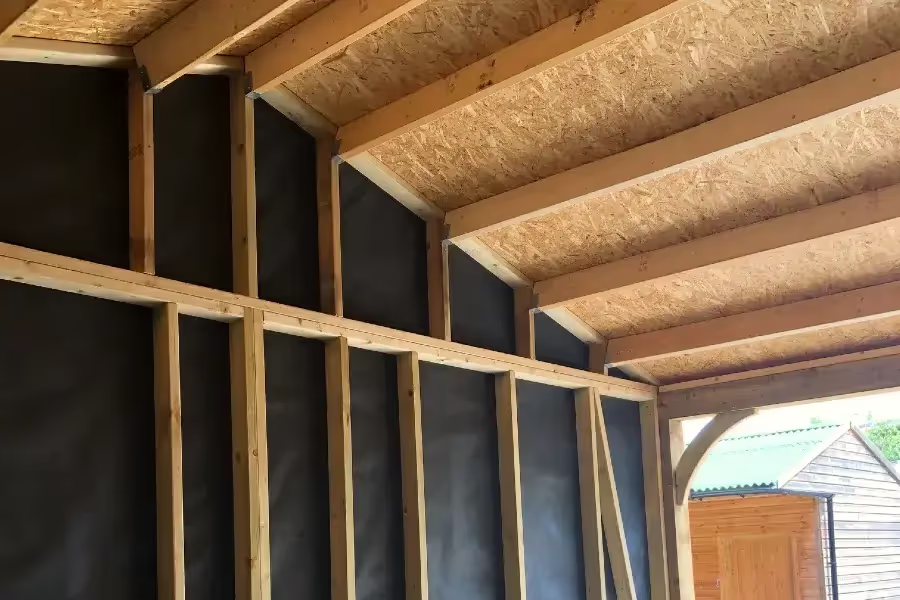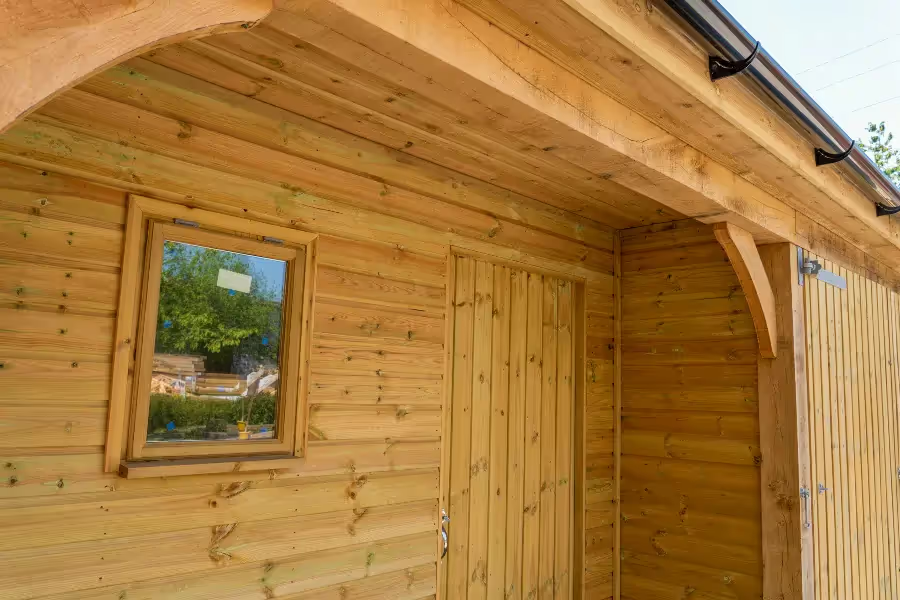
From the foundation to the roof, from eaves to personal doors, each element plays a crucial role in shaping the form and function of a garage. If you’re thinking of building a detached garage on your property, it is worth familiarising yourself with its anatomy.
Understanding the purpose of the parts of a garage will help you choose the perfect outbuilding for your needs. For example, if you can only fit a single-car garage in your driveway, you might want to increase the height of the roof ridge to obtain a steeper-angled roof that can fit trusses, so you have additional storage space.
When you are ready to obtain a quote for a wooden garage, refer to this article to navigate the list of options available to you.
A timber garage is a bespoke wooden outbuilding for housing vehicles, which also serves as storage or a workshop. It is separate from a house, so the structure needs to be solid and self-supporting.
The structure of a garage is composed of the following:
On top of these crucial elements, a garage features many parts that are specific to this kind of outbuilding.
A bay is a space for a car in a garage. For example, a single-bay garage accommodates one vehicle.
You can build your garage to include multiple bays. Not all bays need to be used to house vehicles, though. Some people build a triple bay garage to store two vehicles and turn the third bay to a workshop or gym.
At Chart Garages, our timber garages can be built to fit any number of cars. Each bay has a dedicated double-door, so parking your vehicles is easy and there is plenty of space to walk around them. We offer a range of sizes, including wider bays and deeper garages to also provide storage room for your garden equipment and tools.

The cladding of a garage is the exterior material covering the walls of the structure.
A timber garage typically features shiplap or weatherboard cladding on the exterior and pressure-treated timbers and optional OSB or ply lining on the interior. This protects the building from the elements while saving on materials for the interior.

To keep the garage dry, a breathable membrane (also called a breather membrane) is installed between the exterior cladding and the internal walls.
The membrane is vapour-permeable, which means it provides ventilation but keeps moisture out of the building. A breather membrane plays a key role in preventing water ingress, mould, and damp. This, in turn, keeps the structure solid for a long period of time.

The roof ridge, sometimes referred to as the peak, is the intersection between the two roof planes. It is the horizontal line running the length of the roof.

The gable end of a garage is the point where the walls rise to meet the roof.

Many timber garages feature storage trusses. These are a framework - consisting of rafters, posts, and struts - which better supports the roof.
Roof trusses create storage space above the garage, where you can fit ladders and other large items. These are an option on many of our garages and standard on larger buildings and those with clay or slate tiled roofs.*

The eaves are the edges of the garage roof. These overhang the face of the walls and extend beyond the sides of the building. The overhang allows to keep rain and snow clear of the walls, preserving the wood for longer.

A purlin system is a frame that runs parallel to the eaves and supports the roof of the garage. The system is made of horizontal timber beams fitted along the length of the roof.
Many Chart garages come with a purlin system, although those with a natural tile covering have trusses.*

Soffits and fascia protect the bottom of the roof from the elements. Soffits are horizontal boards that line the underside of the garage’s roof. Fascia is the forward-facing trim that lines the perimeter of the roof perpendicularly to the soffit. The fascia is fixed directly to the lower ends of the roof trusses and guttering affixed to the fascia.
Premium timber garages, like our Chester Garage, come with soffits and fascia as standard.

Many timber garage roofs are lined with Oriented Strand Board (OSB) - an engineered wood product containing strads, firmly held together by adhesives and waxes. OSB has fantastic strength, stability, and moisture resistance properties.

Roofing materials provide a barrier between the elements and the roof of a garage and contribute to the aesthetic of the building.
There are many excellent roofing materials you can use to protect the roof of your timber garage. These include:

At Chart Garages, we offer Onduline, Onduvilla, Tapco tiles, and Cedar Shingles. However, we can design your garage ready to support either slate or clay tiles which can be fitted by your own roofing contractor.
Gutters are a water discharge system. They channel water flow from the roof and direct it to the ground.
If a timber garage does not come with guttering on both the front and rear elevations, we recommend upgrading it, as this protects the wood from heavy rain and snowfall. The timber could suffer significant damage if exposed to water over long periods of time.
.avif)
The car door or doors allow you to drive your vehicle in and out of the garage.
Garage door options typically include:
At Chart Garages, we build timber garages with side-hinged double doors. These are sturdy thanks to their simple construction and easy to open and close, but we can make your garage ready to accept roller doors should you require it.

Detached timber garages often come with a personal door, too. This allows you to enter and exit the building without opening the main garage door.

A personal door is very useful if you need to access the garage when you do not need your car or if you use the garage as storage, gym, or workshop.
*Natural slate and clay tiles to be installed by the client's own contractor.


